#including... spider? tick? mite?
Explore tagged Tumblr posts
Text



check out my sick vacation merch so far
(book in 1st image is a Franklin library edition of David Copperfield and the pin on it is a cat in a coffin that says 'if I fits I sits' lol)
#we went to an antique mall and there were SO many bugs for my collection#including... spider? tick? mite?#i am on vacation rn btw i just couldnt post yet cause it was a surprise for my friend lol
41 notes
·
View notes
Text
Anyway while we're on the subject of public misconception towards living things (which is completely understandable because have you SEEN living things? There's like dozens of them!) here's a fresh rundown of some common mistakes about bugs!
Arachnids aren't just spiders! They're also scorpions, mites, ticks and some real weirdos out there
Insects with wings are always finished growing! Wings are the last new thing they ever develop! There can never be a "baby bee" that's just a smaller bee flying around.
That said, not all insects have larvae! Many older insect groups do look like little versions of adults....but the wings rule still applies.
Insects do have brains! Lobes and everything!
Only the Hymenoptera (bees, ants and wasps) have stingers like that.
Not all bees and wasps live in colonies with queens
The only non-hymenoptera with queens are termites, which is convergent evolution, because termites are a type of cockroach!
There are still other insects with colonial lifestyles to various degrees which can include special reproductive castes, just not the whole "queen" setup.
Even ants still deviate from that; there are multi-queen ant species, some species where the whole colony is just females who clone themselves and other outliers
There is no "hive mind;" social insects coordinate no differently from schools of fish, flocks of birds, or for that matter crowds of humans! They're just following the same signals together and communicating to each other!
Not all mosquito species carry disease, and not all of them bite people
Mosquitoes ARE ecologically very important and nobody in science ever actually said otherwise
The bite of a black widow is so rarely deadly that the United States doesn't bother stocking antivenin despite hundreds of reported bites per year. It just feels really really bad and they give you painkillers.
Recluse venom does damage skin, but only in the tiny area surrounding the bite. More serious cases are due to this dead skin inviting bacterial infection, and in fact our hospitals don't carry recluse antivenin either; they just prescribe powerful antibiotics, which has been fully effective at treating confirmed bites.
Bed bugs are real actual specific insects
"Cooties" basically are, too; it's old slang for lice
Crane flies aren't "mosquito hawks;" they actually don't eat at all!
Hobo spiders aren't really found to have a dangerous bite, leaving only widows and recluses as North America's "medically significant" spiders
Domestic honeybees actually kill far more people than hornets, including everywhere the giant "murder" hornet naturally occurs.
Wasps are only "less efficient" pollinators in that less pollen sticks to them per wasp. They are still absolutely critical pollinators and many flowers are pollinated by wasps exclusively.
Flies are also as important or more important to pollination than bees.
For "per insect" pollination efficiency it's now believed that moths also beat bees
Honeybees are non-native to most of the world and not great for the local ecosystem, they're just essential to us and our food industry
Getting a botfly is unpleasant and can become painful, but they aren't actually dangerous and they don't eat your flesh; they essentially push the flesh out of the way to create a chamber and they feed on fluids your immune system keeps making in response to the intrusion. They also keep this chamber free of bacterial infection because that would harm them too!
Botflies also exist in most parts of the world, but only one species specializes partially in humans (and primates in general, but can make do with a few other hosts)
"Kissing bugs" are a group of a couple unusual species of assassin bug. Only the kissing bugs evolved to feed on blood; other assassin bugs just eat other insects.
6K notes
·
View notes
Text
Was anybody going to tell me that the taxonomy of crustaceans as monophyletic is now known to be incorrect, and the true monophylum accurding to modern science is named PANCRUSTACEA and INCLUDES INSECTS???
In other words, CRABBY FRIENS AND INSECTS ARE MORE CLOSELY RELATED TO EACH OTHER than to Millipedes (and Centipedes, which count as Myriapoda)!!! In addition, Millipedes, "crustaceans", and Insects are all more closely related to each other than to the following:
Spiders, Scorpions, Mites, Ticks, Horseshoe Crabs, Sea Spiders (they're so weird and gorgeous luk at em), Eurypterids (Ark players know), Velvet Worms, Tardigrades
What the fuck (that's not an animal)
EDIT: I realized that none of that really explains the craziest thing. See, "monophyletic" means something that includes one ancestor species and all species descended from it. Crustaceans are only monophyletic if you include insects. That means...
That means there are groups crustaceans that are more closely related to insects than they are to anything else we call a crustacean
104 notes
·
View notes
Text
Possible medicinal plants in Beleriand part one /?
This is a resource I created upon commission for @creativity-of-death regarding medicinal plants that do have more evidence behind them with the treatment of wounds. Thank you again for the commission! Commission information in the bottom of my pinned post
Related post!
I am also very interested in both botany and herblore so I really enjoyed doing this. This post is heavy on plant information and light on world building but I absolutely plan on writing more detailed world building!
This is going to focus primarily on the plant thyme which are primarily used to treat superficial wounds.
Some notes first!
Elves do not suffer full body infection under most circumstances however, wounds can still worsen, become inflamed, and there are factors that can prevent healing which herbs like these can aid in in. I’m going to make a longer post about my thoughts on immunology and elves and the differences between them and humans going through different aspects of human immune systems and the similarities and differences with elven ones but essentially, while I do believe there are microbial infections in the middle earth, elves are largely immune to communicable diseases that affect humans! however, they are not immune to all poisons, venoms and toxins, as we know from certain examples in canon, for example Aredhel’s death
Ethnobotany is notoriously difficult to research as there are so many conflicted sources and it is often difficult to tell what species have been studied, tested, and proved to have medicinal value, which have been proven to not have significant use in this regard and which have simply not been the subject of much research. Especially when it comes to traditional medicinal practices from marginalized cultures and peoples, information is often dismissed, buried or lost. Oral histories or works in translation are often not included in English literature research.
Second note: understanding of the body and of medicine varies tremendously in my opinion throughout the timeline of middle earth. The information included here is largely the information that we know from modern studies, and the language will not necessarily be the same terms of understanding the characters have, for example boards, like “anti-microbial properties” Would largely be understood by first age, elves, and humans to mean plants that assist in the healing of wounds, prevent them from worsening and prevent illness from falling as a result. Throughout history, we see terms like contamination, blood poisoning, and corruption in place of infection before germ theory was widely understood.
OK now for the plants!
Thyme has been proven in some forms to have significant microbial properties. They are some of the best well antimicrobial properties. Thymol a name for oil of thyme* is and has been used in pesticides and medical disinfectants.
Historically, bandages would be coated in oil of thyme to prevent infection, even before the processes of infection were understood. Thyme contains several different subspecies and tends to grow in Mediterranean climates however has been widely naturalized elsewhere.
In Beleriand it likely grew primarily in Ossiriand and Dorthonion but could easy be naturalized in other temperate regions.
* this compound is also found in other plants to varying degrees, but was named after the substance that was first extracted from common thyme
Wormwood, or Artemisia absinthium has also been studied fairly extensively and has been proven to have antimicrobial properties. I know you mentioned spiders and though it has never been tested on spider venoms, it is proven to have anti parasitic properties and has been used to kill other arachnids such as mites and ticks. Interestingly, it has been examined to have neuroprotective properties which might make it useful in antivenoms. These have not been studied as extensively as its antimicrobial properties however.
In Beleriand this is plant that can be easily naturalized throughout temperate regions, especially in fields and foothills. Dimbar, the region of Nargothrond, and the southern hills are some examples.
Calendula (common marigold)
Evidence has shown that topical application can aid in the healing of wounds and in preventing or treating infection. Tinctures and ointments are the most common forms. These flowers grow throughout the temperate world. Overuse could lead to endangerment/extinction easily. Mount Sinai Hospital’s online medical library discusses these properties as does the National Institute of Health. The properties seem to be well proven, especially by ethnobotanical standards!
Marigold primarily grows in warm regions, including warm temperate ones. In Beleriand it probably grew primarily in the west and central regions.
Common tormentil has mild astringent properties which can aid in blood stopping. Creeping jenny or field balm also has similar properties. These both grow throughout temperate climates though tend towards colder regions.
In Beleriand common tormetil could likely grow in Hithlum and in the plains of Eastern Beleriand. Creeping Jenny would likely be found near ponds such as near the Fen of Serech or Twilit Meres.
39 notes
·
View notes
Text
Taxonomy Tournament: Arthropods


Opiliones. This order is commonly known as harvestmen or daddy longlegs. Unlike spiders, they have no silk glands and cannot make webs, but they are able to swallow solid food unlike most other arachnids.
Parasitiformes. This superorder is made up of mites, including ticks, external parasites of mammals and birds that feed on their blood, and the varroa mite, which attacks honey bees and can cause their colonies to collapse.
#animals#biology#polls#poll tournament#zoology#daddy longlegs#arthropods#arachnids#ecdytes#human parasite#mites#ticks#Opiliones#Parasitiformes#0x6dv0x92#animal tournament#Animal Tournament Round 1#spiders
54 notes
·
View notes
Note
taxonomic nightmare but may i request a chelicerate order ranking
sticking with extant ones, here.
Amblypygi - S
my little tree flatcrab spindle angels. maybe other arachnids have chemically interesting venom or are more colorful (amblys can do gray!! and sometimes brown) but amblys are really just suited to my tastes. long-living with both sexes having indeterminate growth, spiny, fast, nonvenomous, arboreal/scansorial, curiously social, and they just look great.
Alfonso says hi.
Thelyphonida & Schizomida — Uropygi? - A
great bugs for most of the reasons shared with above, being fairly closely related to amblys. vinegaroons are the tanks of the tetrapulmonates, built to burrow and clobber things with their freakishly muscular pedipalps. schizomids are very funny guys that deserve better. each group took “ain’t broke, don’t fix” even more literally than the amblypygi and truly all look identical; if you hid arachnologists’ microscopes there’d be a crisis.
Solifugae - A
fast, furious, fluffy: I love these little (and not-so-little) freaks. again, doing it all without venom, their crazy snipping chelicerae are some of my favorite insect anatomy. plus, they’re bizarrely diverse, from the mouth-on-legs of the rhagodids to the classic camel spider look and then there’s the hexisopodids that look like angry fur pillows.
Opiliones - A
there’s so much more to these than the ball-on-sticks (though that’s iconic!) that I used to think they all were. ornate armor and parental care (paternal, in some cases!) from the Laniatores, spindly guys abound, alien drone robots from Dyspnoi (Trogulus), and then whatever pudgy little Siro has got going on. possibly the most creative use of pedipalps, with funky lobster claws, bear trap spike-hell, “spoons?” (cosmetids), pinchy bits, glue traps, and spare leg all represented.
Araneae - B
sure. spiders are cool. everyone knows what a spider is. points for diversity, points for bizarre forms, yeah yeah. can we go home now? also, webs are cheating.
if it was only Liphistius, they’d get an A.
Ricinulei - ????
mysterious. elusive. built like a baked bean. what are they even doing? we don’t know. pay researchers more
Pseudoscorpiones - B
great bunch of little guys! phoresy is fun, and so are venomous crabby pedipalps. they have the best element of surprise—never know where you’ll find them next. in a book? under bark? in a beetle? lots of points for weird social lifestyles in certain species and associated chemical mimicry, plus all the wacky insular species and host specialists.
Scorpiones - C
they’re like pseudoscorpions, only less so. cute in a very dopey way. learning that a scorpion’s anus is at the tip of the tail ruined them for me forever.
Palpigradi - D
adorable but they’re not really doing anything let’s be honest. and I love them for that. you do you little eyeless guys I’m sure I’ll find you someday in the dirt
Acari/Parasitiformes - S
aha! I bet you thought I’d rank them poorly, but no, mites are the best arachnids (though not my personal favorites). if you disagree with that, it probably means you don’t know enough about them. mites can do anything and you are a fool if you doubt them.
yes, this includes ticks. ticks are cool and if you have an issue with this—sounds like a vertebrate problem
~~~~~under the water~~~~~
Xiphosura - C
overrated. great, and I love them, but just slightly overrated. stop stealing their blood pls
class Pycgnogonida - ????
Huh? What?
What? I don’t know. Maybe.
54 notes
·
View notes
Text

(OC: Mortys)
Omg more bug ocs!
Yeahhh it might be weird to choose ticks of all creatures to base an anthro bug oc on, but at the same time, arachnids other than spiders and scorpions (and maybe harvestmen?) are sooooo underrated (like, arachnids don't just include spiders, scorpions, and harvestmen, there's also pseudoscorpions, solifuges (camel spiders), mites, whip spiders, vinegarroons, and, of course, ticks)
So if you don't know about ticks, they are very tiny arachnids that feast on blood. Ticks are usually only known as vectors of disease, but whatever, that's not going to stop me from using an unpopular type of bug for an OC's species
Also fun fact: One of Mortys' surnames, Zech, is meant to be a pun on Zecke (German for "tick").
15 notes
·
View notes
Note
I think this is a silly question: what animals (not including humans) do you think would be any of the earth team's least favorite
i think generally, most Vani would just hate viruses, if those count. they don't really know what constitutes them being alive, so they just see them solely as a source of suffering. "at least parasites seem ALIVE! Viruses just don't have any life signatures..."
most of the Vani wouldn't have any true exposure to animals enough to form negative opinions, and they don't negatively judge creatures by look or biology. however, i think vani like Zahalkro and Lusafree may grow not that fond of little bitey bugs.
Xelzerin may dislike a lot of pest bugs like aphids and pest vertebrates like moles and gophers for the reason of his garden. but on the contrary, he'd LIKE spiders and predator bugs, as well as pest-killing cats. He just wants a nice garden.
Deneko does not like pigeons and seagulls. They shit everywhere, like on his vehicles and buildings.
I think Ohazia would just hate everything, while Baltzival wouldn't have the heart to "dislike" anything.
Any Vani with fur would hate mites and ticks even if the bugs would die immediately upon trying to suck blood. They're itchy as hell and prompt that Vani to feel the urge to bath again and again! Any aquatic Vani would dislike barnacles and lampreys and other sea parasites, even if- yet again- they'd die immediately as they try to latch to the Vani.
TLDR their dislikes would 100% be convenience and ability based, but not really appearance based (but they generally are not fond of being parasitized or inconvenienced). and i cant list them all here without writing a novel about each of the 39 individual Vani opinions on their own personal irksome animals
16 notes
·
View notes
Text
Upcoming Bug Expansion
My most frequent Clanmew expansion requests are for bugs, funny enough! Im not sure why exactly, but I am always happy to encourage people's interest in underrated wildlife so it's a welcome request.
But if you've seen my bug expansions, you'll know that I can't just drop Every Bug in a single post, because there are dozens of individual species that Clan cats would have dedicated words for. So, I'll have to get specific.
The next Clanmew Day is coming up on the 3rd, and I can make an expansion pack for one bug family before then. So, which one?
(NOTE: CLAN CATS DO NOT HAVE CLADISTICS. "BUG" IS A TERM FOR ALL LITTLE CRAWLY THINGS.)
Just pick your favorite, I'll try to include 1 expansion per Clanmew Day and toss up a poll like this a couple days before. 5 options each time.
(Next time I'll replace tonight's winner with flies, pond bugs, worms and grubs, or snails and slugs, whichever one I feel like that day)
I plan to eventually do All The Bugs but this is just about order.
34 notes
·
View notes
Text
so i kinda decided why not kinda add a few arachnids and like a few crustaceans (LAST TIME I DID NOT KNOW A SILLY PILL BUG WAS A CRUSTACEAN, I MEAN PAL HAS THE NAME BUG.)
So uhh, even though this is “BUG WARS” let’s give the arachnids and crustaceans a chance.
BTW WHAT EVER WINS THIS ROUND WILL GO TO ROUND 17 (ROUND 17 WILL INCLUDE BEES, MOTHS, AND THE WINNER OF CRUSTACEANS OR ARACHNIDS.)
CRUSTACEANS INCLUDE : PILL BUGS, STARFISH, SHRIMP, LOBSTER, and CRAB.
ARACHNIDS INCLUDE : TICKS, SCORPIONS, TARANTULAS/ SPIDERS, MITES, and ofc what I said earlier for the people who don’t like huge silly spiders we got normal SPIDERS.
LETS CONTINUE ROUND 17
oh yea btw if you did read this little part thanks, btw these special round where they are not bugs will be called uhhhhhhhhhh “ARACHNIDS OR CRUSTACEANS WARS” horrible idea but it works.
and yes I did google what in the world is a crustacean and a arachnid cuz I needed more than one. OMG SO MUCH TO READ.
#bug wars#silly#polls#arachnids#crustaceans#pill bugs#starfish#shrimp#lobster#crab#ticks#scorpions#tarantulas#spiders#mites
9 notes
·
View notes
Text
The Hidden Dangers of Dust Mites: Why You Need Control Services in Dubai

Dust mites are tiny creatures that live in your home, often hidden in places where you might not expect them. They thrive in warm and humid environments, and unfortunately, Dubai’s climate provides the perfect conditions for these pests. Though they are too small to be seen with the naked eye, dust mites can cause significant health issues, especially for people with allergies or respiratory conditions. This article will explain the hidden dangers of dust mites and why you need Dust Mite Control Services in Dubai and Pest Control Services in Dubai to protect your home and health.
What Are Dust Mites?
Dust mites are microscopic creatures that belong to the arachnid family, which also includes spiders and ticks. They feed on organic matter, such as dead skin cells that humans and pets shed. These tiny pests are often found in bedding, upholstery, carpets, and other areas where people rest or spend time. Despite their name, dust mites are not insects but rather tiny creatures that are closely related to spiders.
Where Do Dust Mites Live?
Dust mites thrive in warm, humid environments. They are commonly found in the following places:
Bedding and mattresses: Dust mites love to live in your bed where they can feed on dead skin cells.
Carpets and rugs: Dust mites can live deep within carpet fibers, where they remain undisturbed.
Upholstered furniture: Sofas and chairs often trap dust mites and their allergens.
Curtains and drapes: These areas are perfect for dust mites to hide and reproduce.
Health Risks of Dust Mites
Dust mites are not dangerous in the traditional sense, but their presence can lead to several health issues. The main problem comes from the allergens they produce, which can trigger allergic reactions or worsen existing respiratory conditions.
1. Allergic Reactions
The body’s immune system reacts to dust mites as if they are harmful invaders. When dust mites' waste particles or dead bodies are inhaled, they can cause allergic reactions such as:
Sneezing
Runny or stuffy nose
Itchy or watery eyes
Coughing
Skin rashes or eczema
For people with dust mite allergies, these reactions can occur year-round, especially if their home is not treated for dust mites.
2. Asthma
Asthma patients are particularly vulnerable to dust mites. The allergens produced by dust mites can trigger asthma attacks, causing symptoms such as:
Shortness of breath
Wheezing
Tightness in the chest
Difficulty breathing
If you suffer from asthma or have family members who do, controlling dust mites in your home is essential for maintaining good respiratory health.
3. Other Respiratory Problems
Dust mites can also contribute to other respiratory conditions, especially for people with existing sensitivities. Conditions like bronchitis, sinusitis, and rhinitis can be worsened when dust mite allergens are present in the environment. Continuous exposure to dust mite allergens can result in chronic respiratory problems.
Why You Need Dust Mite Control Services in Dubai
Given Dubai’s warm and humid climate, dust mites are a common problem in many homes and businesses. Without proper treatment, these pests can multiply rapidly and cause long-term health issues. That’s why Dust Mite Control Services in Dubai are essential for protecting your home and health.
1. Expert Knowledge and Treatment
Professional dust mite control services have the expertise to identify and treat areas where dust mites are likely to thrive. Pest control experts in Dubai use effective methods to eliminate dust mites and reduce allergens in your home. These experts also know how to manage the humid conditions in Dubai that contribute to dust mite growth.
2. Safe and Effective Solutions
Pest control services in Dubai offer safe, non-toxic methods to eliminate dust mites without harming your family or pets. Unlike DIY solutions, professional services ensure that the treatment is thorough and lasts long-term.
3. Improved Air Quality
By reducing the number of dust mites and their allergens, pest control services can improve the air quality in your home. This can lead to fewer allergy symptoms and better overall health, especially for individuals with asthma or other respiratory conditions.
4. Prevention of Future Infestations
Dust mite control services not only get rid of the current problem but also prevent future infestations. Pest control experts will advise you on ways to reduce dust mite growth, such as using air purifiers, regularly washing bedding, and reducing humidity levels.
How Pest Control Services in Dubai Help with Dust Mites
Pest control services in Dubai offer a range of treatments to combat dust mites. These services are comprehensive and designed to address both immediate and long-term concerns.
1. Comprehensive Inspection
The first step in any professional pest control service is a thorough inspection. The pest control team will check all areas of your home where dust mites are likely to be found. This includes mattresses, carpets, furniture, curtains, and other soft furnishings. Identifying the problem areas allows for targeted treatment.
2. Targeted Dust Mite Treatments
Once the infestation is identified, pest control professionals use specialized treatments to reduce dust mite populations. This can include:
Steam cleaning: Steam cleaning is highly effective at killing dust mites and removing allergens from soft furnishings.
Chemical treatments: Safe, non-toxic chemicals can be applied to surfaces where dust mites live to eliminate them and prevent future growth.
Vacuuming with HEPA filters: High-efficiency vacuum cleaners are used to remove dust mites and their allergens from carpets, upholstery, and other surfaces.
3. Humidity Control
Controlling humidity is essential in preventing the growth of dust mites. Pest control services in Dubai can help you understand how to keep your home’s humidity levels in check. This can include using dehumidifiers or advising on proper ventilation to reduce moisture buildup.
4. Ongoing Maintenance and Advice
Dust mite control is an ongoing process. Pest control services in Dubai offer follow-up treatments and advice on how to maintain a dust-free environment. Regular cleaning, washing of bedding, and using mattress encasements can help prevent dust mites from returning.
Additional Tips to Control Dust Mites in Your Home
While professional Dust Mite Control Services in Dubai can handle the heavy lifting, there are also several steps you can take to reduce dust mites in your home:
1. Wash Bedding Regularly
Washing sheets, pillowcases, and blankets regularly in hot water can kill dust mites and remove allergens. Make sure to do this at least once a week.
2. Use Dust Mite-Proof Covers
Encasing your pillows, mattresses, and box springs in dust mite-proof covers can prevent dust mites from settling in and reproducing. These covers create a barrier that dust mites cannot penetrate.
3. Keep Humidity Low
Dust mites thrive in humid environments. Using dehumidifiers and air conditioners to keep the humidity in your home under 50% can reduce dust mite growth.
4. Vacuum Frequently
Regular vacuuming with a vacuum cleaner equipped with a HEPA filter can remove dust mites and allergens from carpets, rugs, and furniture. It is essential to vacuum at least once a week.
5. Declutter Your Home
Dust mites love to hide in cluttered areas, such as piles of clothes or piles of paper. Reducing clutter can make it easier to clean and eliminate dust mites.
Conclusion
Dust mites are often invisible to the naked eye, but their impact on health can be significant. Whether you are dealing with allergies, asthma, or respiratory problems, controlling dust mites in your home is essential. Professional Dust Mite Control Services in Dubai can provide safe, effective treatments that eliminate dust mites and improve air quality, making your home a healthier place to live. Additionally, implementing regular cleaning routines and controlling humidity levels can help prevent dust mites from returning.
#Dust Mite Control Services Dubai#Pest Control Services in Dubai#Dust Mite Allergy Prevention#Home Pest Control Dubai#Dust Mite Infestation Solutions
0 notes
Note
Captain bogleech do you have handy references for the faces of mosquitos, fleas, houseflies, and ticks? I'm picking at an idea of a character who is themed around disease, and is strictly a source of disease and not diseased themself so like... Worlds best spreaders. The one I'm most locked on is miss aedes aegypti because of her good taste in stripes. SO in season (I dontactually know if stripes are in season)
Yes! First its good to know how a "normal" insect mouth is set up:

In most insects, like a grasshopper or a cockroach or the majority of beetles, there's a labrum covering the top of the mouth, kind of like a duck bill! The chompy mandibles are under that, then there are the maxilla to either side of each mandible, which include the "palps" it uses like little hands to hold food. The labium is the bottom part, and also has another set of palps! @revretch has gone into lots of detail on this but they put it best by explaining that the insect mouth is like a four sided box, formed by the labrum, maxilla and labium, with the mandibles usually inside the box. It's just that lots of insects do weird things with these parts, and many have big giant mandibles that always stick out.

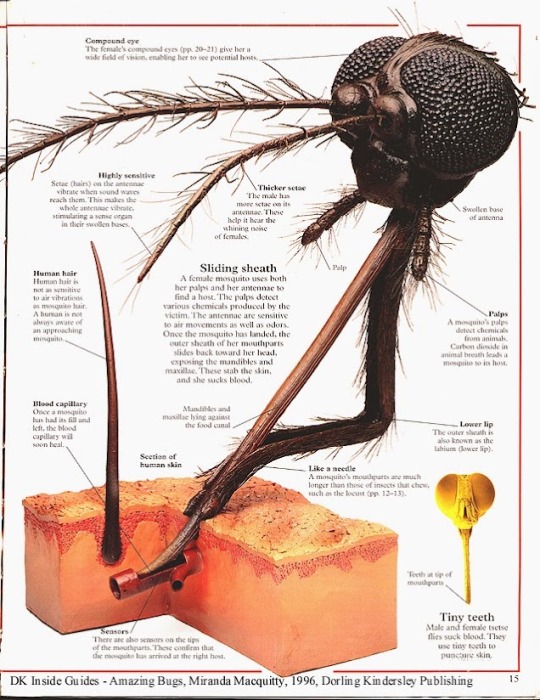
Mosquitoes have all these parts, but they're all long and thin, and they all fold together to form the proboscis, with some of them bending back as it drills into flesh.
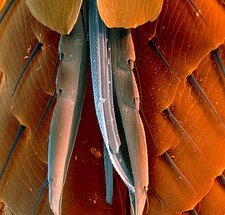

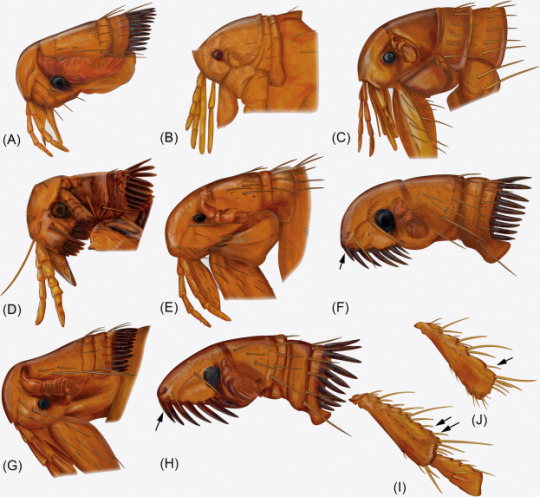
Fleas have similar to mosquitoes, but shorter and more compact. And many species have that AWESOME looking "mustache" of thorns right above the mouth, used for anchoring to furry hosts while they feed :)

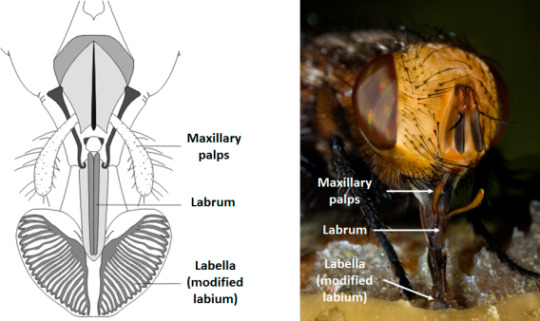
In the non-biting flies, the mandibles are GONE, the mouth extends on a flexible hose and the labella is modified into a big flaring two-lobed pad. Digestive enzymes flow down the labrum and into grooves on the pad, so it works like a sponge soaked with acid :)

Ticks are a lot different because they're arachnids rather than insects, and arachnids have fewer mouthparts; normally just one pair of palps and one pair of chelicerae, which are the "fangs" in spiders! Below all that is an arachnid's real mouth, usually just a tiny little hole. In ticks, the palps are fused into two flat flippers, which the tick uses to pinch the skin of its host. The chelicerae are formed into a pair of jagged "scissors," if the blades of scissors were on the outside! These dig in and widen a small hole. Then the mouth is surrounded by a long extension, the hypostome, which is thickly covered in sharp tiny toothlike blades. Look how rad it is:
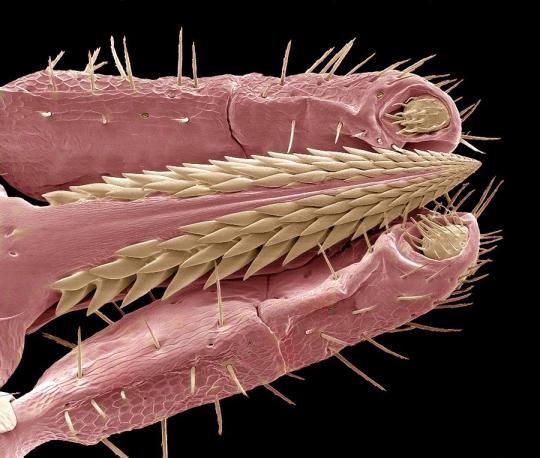
I say this a lot but the entire part people think of as the "head" of a tick is really just the mouth, because ticks are related to mites, and in mites, the head is fused entirely with the body. So when ticks have eyes, they're here:
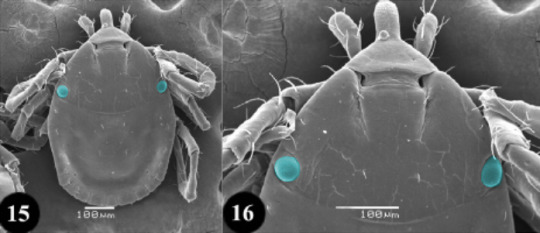
It's tragic the world sees ticks as fat blobs with tiny heads, when in fact they are just big heads with legs.
For fun here are some of my Mortasheen monsters that hybridize humans with all the above, though my mosquito is very dated and due for a big overhaul someday; I didn't bother trying to merge real mosquito mouthparts with fleshy human ones and just had the whole mouth spiral together:
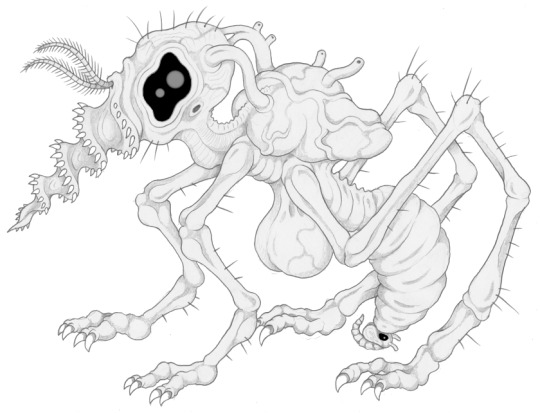
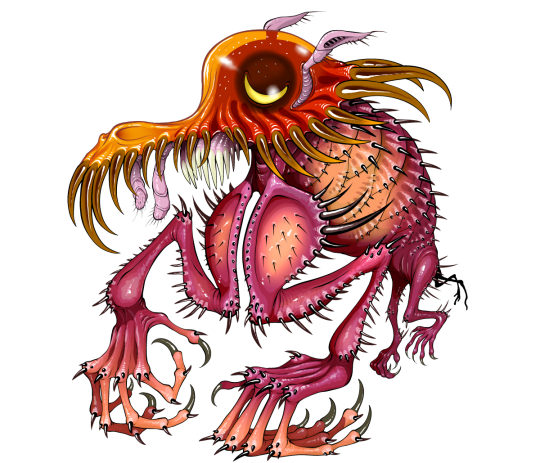



I also drew the flea without its "helmet" piece first, and went on to draw several alternate helmets :)
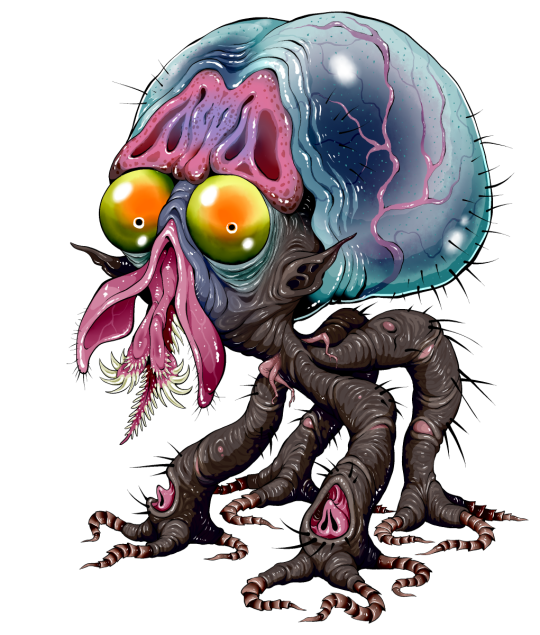
I put the most effort into the tick as you can tell. I also incorporated the fact that they smell with their front legs. :)
274 notes
·
View notes
Text
Words/Phrase of the day
“to the manner born”
A person who is “to the manner born” is one who has acquired genteel tastes and habits by virtue of having been born into a privileged class: This expression is sometimes mistakenly rendered as “to the manor born.”
unsub: Abbreviation of unknown subject of an investigation.
defenestration: An act of throwing someone or something out of a window.
Arachnet vs Arachnid:
Arachnet are, as its name suggests, spider-like Slugs. These Slugs are empowered with the element of earth and are uncommon. While in its protoform it can spin web lines and create small web nets. Its preferred habitat is Deaddrop Cavern and the Cavern of Time. Its power type is spinning webs and nets.
The term arachnid refers to a class of animals that includes spiders, scorpions, mites, and ticks. Most arachnids have a segmented body divided into two regions, with the front part bearing four pairs of legs, but no antennae.
Employe is a rare dated alternative spelling of the more common employee. (From French "employé")
~~~
I was watching clips of The Wolf of Wall Street -- I don't know if I can handle the whole movie right now -- and "to the manner born" is how Denham (the FBI agent) described the "others" on Wall Street, who are unlike Jordan, whom is a self-made man. I had never heard that phrase before. However, I have. There's a British series called "To the Manor Born" that I actually saw when I was a very small child....and forgot. Isn't that a phenomenon?
They called Josh Hartnett's character in Trap an unsub.
Once again, another cartoon using aged vocabulary. I've been watching "The Spectacular Spider-man" this week (yes, the one from 2008, I only just discovered it via YouTube by accident this week. Actually, this is how I discover most animation LOL) I'm really loving it, they use a lot of dope words, you'll see more in future posts. "I don't know who he is, but he is NOT in my employe", that is what the pale man, who sounded like Keith David, said. He was talking to Spidey about the Green Goblin. He used a dated word. Why? The French version too, you already know that fascinates me.
Throughout the show, others and Spidey himself refer to him as arachnid. They say it quite often. There's maybe 12-13 episodes, that word is used in at least 5 of them. Defenestration is also used by Spidey. I know it's not a new show, but I'm glad that the kids of that time had a show that cared about enhancing their vocabulary. Though defenestration is probably not a word they would have used in their everyday conversations, at least they know that there is such a word to describe a strange act like that....and it may even show up on a spelling test.
#Words of the day#phrases#trap#Words#to the manner born#unsub#dictionary#definition#vocabulary#wolf of wall street#defenestration#Arachnet#the spectacular spider man#arachnid#employe#genteel#transformers#spiderman#spider-man#cybertronics#french#france#language#The Wolf of Wall Street#the Green Goblin#spidey
1 note
·
View note
Text

Hello everyone! I’ve got a different post in store for you today.
With summer in full swing, outdoor activities such as hiking, backpacking, and general frolicking around in nature have reached the peak of their popularity. However, nature is full of hazards, such as sharp edges, large pits, slenderman, and deep and quick-moving water.
One such hazard is ticks! Ticks are tiny bloodsucking parasites that can be found in tall grass and deep brush, and feed on mammals, birds, and even reptiles and amphibians on rare occasions.
Ticks are ARACHNIDS, NOT INSECTS. This means they are closely related to spiders and centipedes! More specifically, ticks are a kind of mite, which are incredibly tiny and malevolent creatures that run around and generally cause chaos.
There are over 90 species of tick in North America alone, and they all vary greatly in distribution, size, and appearance. Despite this, all of them share a few key traits which can help you easily identify them.
Adult ticks are 3-5 mm long on average, though this varies from individual to individual and is subject to change from a variety of factors, including species and the amount of blood consumed.
Because ticks are arachnids, they have EIGHT LEGS and TWO MAIN BODY PARTS: the CEPHALOTHORAX and the ABDOMEN.
Generally, ticks are somewhat flat, like a coin. This offers protection against being stepped on by large and heavy creatures. As a tick consumes more blood, however, its body inflates until it more closely resembles a grape with legs.
Tick’s ‘heads’ are not actually heads at all, but are actually a specialized and elongated mouth. This mouth, called a capitulum, resembles a pair of pliers with a needle or siphon in the middle. This specific shape helps them to tear open a hole in the skin of the animal they’re parasitizing and drink its blood. Obviously it’s more complicated than that, and I’m definitely not describing it accurately, but ticks are gross. Let’s move on.
Ticks have an oval-shaped abdomen. The ‘shield’ on its back can be used to identify its exact species. For example, dog ticks have white markings resembling racing stripes, while long star ticks have a single white spot in the middle.
With all this helpful information, you should be all set to keep an eye out for any ticks that attempt to crawl up your leg while you’re hiking. My advice to you is to wear pants and long sleeve shirts while out and about in nature, and also to check the back of your neck and your hair after an excursion; ticks like to hide there.
#entomology#arachnids#tw ticks#tick season#not actually an insect#But entomology does kinda sorta include other arthropods like arachnids so it’s okay#the more you know#zoology#information#helpful#fyi
0 notes
Text

Arachnids are a class of invertebrate animals that encompasses ticks, mites, spiders, and scorpions. Many possess venom or silk glands. biologist: a scientist involved in the study of living things. chemical: a substance formed from two or more atoms that unite (bond) in a fixed proportion and structure. For example, water is a chemical made when two hydrogen atoms bond with one oxygen atom. Its chemical formula is H2O. Chemicals can also be used as adjectives to describe the properties of materials that are the result of various reactions between different compounds. A chemical signal is a message that is transmitted from one location to another using molecules. These signals are used for communication by certain animals, including bacteria. Glare: Also called direct glare, it is light that travels directly from a light source and into someone’s eyes. It reduces the ability to see at night. Direct glare is one of three types of light pollution. Navigate: To find one’s way through a landscape using visual cues, sensory information (like scents), magnetic information (like an internal compass), or other techniques. Reflected Light Detection: Spiders that fall into water utilize reflected light to find land. This behavior is observed in certain species of spiders, particularly those that inhabit areas near water bodies or have a tendency to venture close to water sources. Survival Mechanism: When spiders accidentally fall into water, they rely on the reflection of light on the water's surface to orient themselves and locate nearby land. This instinctive behavior is crucial for their survival, enabling them to avoid drowning and find their way back to safety. Light Sensitivity: Spiders possess specialized sensory organs that enable them to detect light variations with remarkable sensitivity. They are capable of perceiving even subtle changes in light intensity and direction, which aids them in navigating their environment, including when they find themselves in water. Utilization of Polarized Light: Spiders may also utilize polarized light, which is light that vibrates in a specific direction, to discern the direction of land. By detecting the polarization patterns of reflected light on the water's surface, spiders can determine the location of nearby surfaces and move towards them. Adaptation to the Environment: This ability to use reflected light to find land highlights the adaptability of spiders to diverse environments. It showcases their remarkable capacity to utilize environmental cues for survival, even in challenging situations such as accidental immersion in water. Implications for Research: Studying spiders' behavior in response to water immersion and their use of reflected light could provide valuable insights into both spider biology and the broader field of animal navigation. Understanding the mechanisms behind this behavior could inspire new strategies for navigation and orientation in artificial systems. species: a group of similar organisms capable of producing offspring that can survive and reproduce. spider: A type of arthropod with four pairs of legs that usually spin threads of silk that they can use to create webs or other structures. surface tension: The surface film of a liquid is caused by the strong bonds between the molecules in the surface layer. wave: A disturbance or variation that travels through space and matter in a regular, oscillating fashion. Zoology is the branch of biology that focuses on the study of animals, encompassing their structure, physiology, behavior, classification, and evolution. Here are some key points about zoology: Classification and Taxonomy: Zoologists classify animals based on shared characteristics and evolutionary relationships. This helps organize the vast diversity of animal life into manageable groups. The Linnaean system of classification and the more modern cladistics approach are essential tools zoological research
1 note
·
View note
Text
Health Benefits of Pest Control
Pest control is the practice of preventing and controlling pests. Pests can cause damage to crops and property, spread diseases, and disrupt ecosystems. Pest control professionals use a variety of techniques to manage pests.
New homes, especially those in housing estates, can be a magnet for pests. They can also be vulnerable to termite invasion. To know more about Pest Control Narangba, visit the Bug Out Pest Solutions website or call 0426263320.
Pests are not just annoying, but they can also damage property and contaminate food. Termites, for example, can eat through wood and weaken buildings over time, leading to expensive repairs. Rodents can gnaw on electrical wires and increase the risk of fires. In addition, pests such as cockroaches and mosquitoes carry diseases that can cause health problems for the people living in a building.
Regular pest control maintenance helps prevent these damaging effects and protects a property’s value. It can also save money in the long run by preventing expensive home repairs.
Detecting pests in the house is easy, but it’s not always possible to spot the hidden damage they cause. Signs of infestation include rat droppings, scurrying sounds at night, and unexplained pungent smells. These signs can indicate that rodents, cockroaches, and other pests are hiding in your home. They can also damage your home’s structure and lower its market value. Getting rid of these pests is essential for your family’s safety and comfort.
Pests can spread diseases to humans through their droppings and contaminated food. Rodents and insects can transmit bacteria, such as salmonella and hantavirus, which cause illnesses like gastrointestinal upset and fever. Some pests, such as ticks and mosquitoes, can carry viruses that cause diseases like malaria, dengue, and Lyme disease.
Crawling or walking pests, such as rodents, cockroaches and Indian meal moths, can spread germs as they crawl on garbage, decaying matter, and sewage. They can also transfer these germs through their shed skins, fecal droppings, and saliva to foods and food surfaces.
Having pests in your home can lead to a number of health problems, such as allergic reactions and asthma. You may notice signs of pest infestation, such as gnaw marks, droppings, smear marks and foul odors. It’s important to take action before these pests cause damage and affect your health. A qualified pest control technician can help you eliminate pests safely and effectively.
Many pests release allergens into the air that can trigger asthma and other respiratory symptoms in people who are sensitive. For example, cockroaches have allergen proteins in their saliva, feces, and shed skin. These allergens become airborne and contaminate indoor environments. Cockroaches can also cause asthma attacks in children and make existing symptoms worse.
Other common allergy-triggering pests include flies, stink bugs, and spiders. These insects can contaminate food with bacteria and other pathogens and cause allergic reactions in people who are prone to them. Stink bugs produce a vapor when crushed that can cause allergies in some people. In addition, some caterpillars have urticating hairs and spines that can cause itching and allergies in some people.
Pest-related allergens can be reduced by keeping a clean home and throwing out trash regularly. In addition, an air purifier with a HEPA filter can help trap and remove dust mite allergens from mattresses and upholstery. It’s also a good idea to keep windows closed during high pollen seasons and wash bedding in hot water on a regular basis.
Pests can cause a wide range of health threats for pets. They can carry parasites and bacteria that lead to diseases such as heartworm, rabies, and Lyme disease. They can also bite or sting pets, causing pain and discomfort. In some cases, venomous bugs like snakes and spiders can be fatal to cats and dogs. Pet owners can limit the threat by keeping their pets on a leash, avoiding tall grass and bushes, and making sure that trash cans are securely closed. To know more about Pest Control Narangba, visit the Bug Out Pest Solutions website or call 0426263320.
Mosquitoes are another common concern for pet owners. They can cause painful, itchy welts on animals that are similar to those caused by mosquito bites on humans. In addition, some species of mosquitoes can carry viruses that can lead to heartworm disease. Other venomous pests include ticks, fleas, and mites. Fleas can cause itching and anemia in pets, while ticks can transmit diseases such as Rocky Mountain spotted fever and Lyme disease. Stinging pests such as bees, wasps, and hornets can also harm pets by causing severe allergic reactions.
#pest control brisbane#termite control brisbane#termite control solutions#pest control#bug control services#cockroach control solutions#cockroach control solutions in brisbane#pest control services#termite inspection#cockroach termination services#Bed Bug control Morayfield#Cockroach control Redcliffe#pest control narangba#pest control burpengary
0 notes